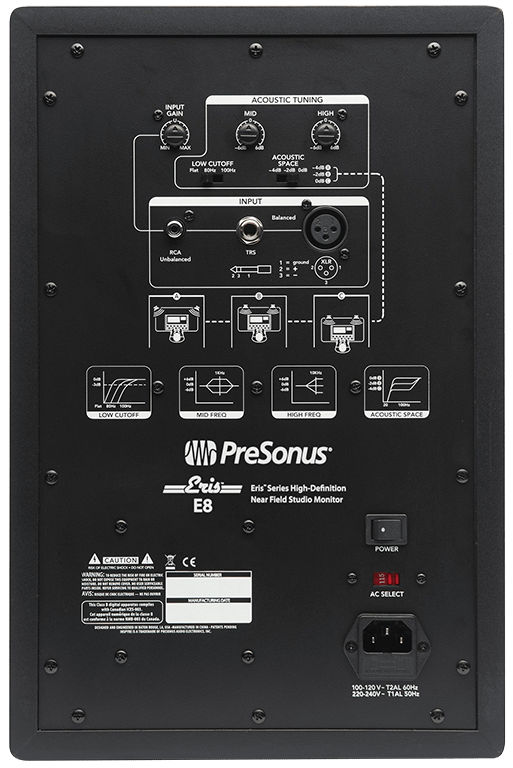
Review: Presonus Eris Active Studio Monitors
Active nearfield monitoring at ‘it’d be rude not to’ prices?
This, surely, is Presonus’s break-out year. After a long period of being best known for audio interfaces, and then the StudioLive digital mixer, Presonus has released a plethora of new gear in 2013, including networked PA products, updates to the StudioOne DAW, and, for our purposes here, two ranges of studio monitors. Sceptre is the primo dual-concentric design while the active Eris Series — the E5 and E8 models — make no bones about its ambitions to provide quality studio monitoring at an almost irresistible price.
HOW LOW CAN YOU GO
Despite their low retail price my first impression of the Eris speakers was favourable. I sparked up the E8s first and found the frequency response to be fairly linear overall. They’re slightly recessed across the mids between 400Hz and 1kHz and slightly forward in the presence region between 2kHz and 4kHz but without any significant peaks or dips that could lead to mixes being skewed to compensate. The low-frequency response of the E8 is quoted as plumbing some basso-profundo depths (35Hz, in fact). The response graph illustrates that while the speaker loses energy below 50Hz it’s still quite strong at 40Hz and there is some sound being produced all the way down to 30Hz. The high frequency range is quoted as extending up to 22kHz (there’s no point asking me to confirm that, I begin to peter out at about 12kHz).
The Eris E5s are similar but there are a few important differences. The low frequency response is not as strong below 60Hz (not surprising given the smaller driver and cabinet) but the 80Hz to 160Hz octave is quite prominent giving the E5 a ‘full’, rather than a deep, sound. The mids are slightly recessed but in a narrower band between 600Hz and 800Hz. The tweeter is crossed over at a higher point (3kHz) compared to the E8 (2.2kHz) and it’s a bit peaky around 2.5kHz.
SPACE RESTRICTIONS
Size can be a factor in choosing monitors. Many home studios are set up in restricted spaces and the E5s are a pretty standard size that will fit almost anywhere. The E8s are louder and extend down to lower frequencies but they take up more real estate. As both models have the power switch, connections and tone controls on the rear panel they’ll need to be mounted somewhere that allows access ’round the back. For mine, it makes sense to have the connections and EQ on the back as they tend to be set-and-forget… but the power switch needs to be accessed twice every time the speakers are used and, ideally, should be on the front, perhaps discreetly incorporated into the illuminated logo if aesthetics are a concern.
The built-in amps are a Class AB analogue design and well matched to the drivers – neither model feels under-powered. Maximum volume is quoted at 102dBSPL (E5) and 105dBSPL (E8) at 1m and there’s plenty of volume for normal monitoring. Thermal and overload protection circuits are provided and the power supply offers the convenience of operating at variable voltages. The dispersion on both models is quite strong on-axis and they sound best when they are pointed straight at you. The sound stage is not particularly wide or deep but that was only noticeable when comparing the Eris speakers to far more expensive monitors. I wonder whether the now common elliptical wave guides would be an improvement. The same comparison revealed some blurring of the transients in the high frequencies but at these prices I’m beginning to feel like a quibbler.
NEED TO KNOW

TRANSLATION
Recreationally, most people like listening to their hi-fi with some added low end, especially at low to medium volumes. Meanwhile, if monitor speakers are exaggerated in the low end then anything mixed on them could turn out to be bass-shy. Studio monitors are all about translation: how does music mixed on the speakers translate to the outside world? The most important aspect of this is a flat and extended frequency response. By this measure the E8s probably have an advantage over the E5s for monitoring because of the E5’s relatively prominent low mids. The E5s, on the other hand, could be preferred for general listening and at this price point I can imagine them being used either side of a computer monitor or as part of surround sound AV systems.
NAME YOUR PRICE
If you asked me to name the price of these monitors after a blind test, I’m not entirely sure what I’d say, but it would definitely be considerably more than the Eris RRP. Eris plays in a competitive, price-sensitive end of the market, but has some competitive advantages with its comparatively-sophisticated EQ features. The EQ options are handy and the speaker’s accuracy across the frequency spectrum should ensure mixes will translate outside the studio. Eris series packs Class AB amps and uses the Kevlar woofers, which also points to the fact Presonus hasn’t skimped on these monitors. But in the end, it’s all about the sound. And in this regard Eris is a bargain.
















RESPONSES